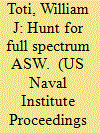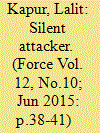| Srl | Item |
| 1 |
ID:
132189


|
|
|
|
|
| Publication |
2014.
|
| Summary/Abstract |
An antisubmarine warfare doctrine adopted U.S. Navy-wide nearly a decade ago still applies, now more than ever.
During the Cold War, the U.S. Navy (particularly the submarine force) specialized in and excelled at antisubmarine warfare against the Soviet Union. But with the demise of the Soviets, ASW was put on the back-burner as an activity irrelevant to modern conflict. Over a decade passed before submarines would again be considered a serious threat to national security. During that time the nature of the submarine threat changed, so when the Navy "rediscovered" ASW, it learned that traditional, sensor-based methods of fighting against submarines, while important, could no longer ensure victory. To respond to this new threat, a new approach emerged in 2005, one that became known as "Full-Spectrum ASW." Quickly adopted as Navy doctrine, the concept pursued a more holistic approach to solving the submarine problem. This first-ever published treatise on the concept should explain how the doctrine was developed, in the hopes that a more thorough understanding of the concept will lead to better implementation.
|
|
|
|
|
|
|
|
|
|
|
|
|
|
|
|
| 2 |
ID:
138645


|
|
|
|
|
| Summary/Abstract |
Soon after Lt Gen. A.A.K. Niazi surrendered to Lt Gen. J.S. Aurora on 16 December 1971, the Indian Navy (IN) was tasked to prepare Bangladesh ports for resumption of seaborne traffic, including clearing their approaches. The Mukti Bahini was known to have laid influence mines across the entrance to Pussur River (leading to Chalna and Khulna), while interrogation of Prisoners of War (POWs) revealed that the Pakistan Navy (PN) had laid 94 moored contact mines in the approaches to Chittagong. IN ships Cannanore (a coastal minesweeper), Bulsar and Bhatkal (both inshore minesweepers) began their task on 18 January 1972. This marks the only time that the IN has carried out minesweeping under operational conditions. Given IN aspirations for sea control, it would be wise to factor in the lessons from this experience.
|
|
|
|
|
|
|
|
|
|
|
|
|
|
|
|